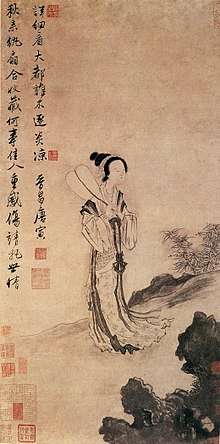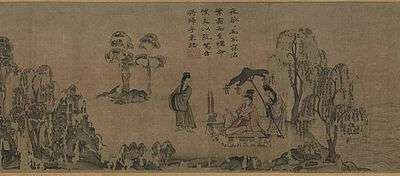Lào zi
Lào zi (Chinese: 络子) or Tāo zi (Chinese: 绦子) is an ancient appellation in China refers to knotting craft. In ancient literature, the words Lào zi is actually Chinese knotting, however, the name of Chinese knotting is summarised by Lydia Chen in 1980s.[1] The two of the words "Lào zi" and "Tāo zi" means the same in many case, Lào (Chinese: 络) is specific meaning of knotting, enmeshing, and wraping[2]; and Tāo (Chinese: 绦) means lace or flat ribbon woven from silk thread that can decorate clothing[3].

According to Dream of the Red Chamber, making Lào zi means making knots that can be used on waist as knotting belt, can be as decorative knots with tassel hanging for small object or furnishing (similar like Norigae in Korean costume culture), can be knotting a net sachet for containing small objects.[4]
The knot at the waist by ribbon can be seen from many artworks especially in the beauty painting and ancient literature description recorded that the tradition of knot ribbon can be traced back Spring and Autumn Period (770-476 BCE), for example in Zuo zhuan·Zhao Gong illustrate the tradition of tied ribbon belt as knot(s).[5]

References
- Chen, Lydia. The complete book of chinese knotting : a compendium of techniques and variations. Tuttle Publishing. p. 5. ISBN 9781462916450.
- "The meaning of 络 (lào)". 漢典.
- "The meaning of 绦 (Tāo)". 漢典.
- "紅樓夢/第035回" [Dream of the Red Chamber·Chapter 35]. Wikisource. Retrieved 2020-07-14.
- "春秋左传·昭公" [Zuo Zhuan·Zhao Gong]. Wikisource. Retrieved 14 July 2020.